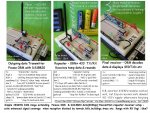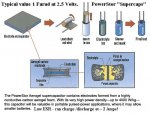microman171
Member
Hey Guys,
I'm wanting to make a solar powered node for my data logger, and I have chosen to use the HopeRF module.
I read here that the enable pin doesn't actually fix, so after a bit of a steam, I made a work around with a BC337 on the 0v pin.
I have a 08M setup with a thermistor, and a sense wire hooked up to the solar cell (Can I use a higher ohm'ed resistor than 10k? I don't want to waste energy from the cell...). The HopeRF unit is set up for transmit and receive on pin 1 and pin 3 (with diode...).
Is the transistor deal all wrong? Should I be switching high or low (+5v or 0v).
The problem is as soon as I wire in the HopeRF module, the 4700uF capacitor holding charge drops from about 5.6 / 5.7 (from the solar light inverter) to about 1.8 in slightly less than a second. I'm sure it's about current draw, (I haven't measure it yet), but it really shouldn't be drawing any, (there is no ground connection until the NPN base is high!).
I haven't drawn up any schematic, but it is simple nough to explain: I have the ground pin wired to the collector, pin 0 (08M) wired to the base, and the emitter wired to ground. No resistors or anything, just point to point. Pin 0 is pulled high when I want to enable the unit (I also have a great looking bright blue LED to indicate when pin 0 is high).
About the actual solar light itself; after reading about UV and moisture on a previous topic, I have decided to make it out of uPVC pipe. I don't want my brand new HopeRF units to be corroded by the moisture... I won't have a clear spot for the light, as that is just asking for trouble. The base will be some type of removeable fiting (maybe a screw type PVC fitting, but maybe just a peice of plexiglass bolted over an O ring...)
Been working on this aspect of the project since yesterday (not all that long =D), but it is the school holidays - so I have plenty of time. If you guys don't reply for a while, I'll be working on the wireless router end (I want my project to twitter, so I hacked an asus router and intalled python).
Long post, but thanks for reading it (or reading the basics!)
I'm wanting to make a solar powered node for my data logger, and I have chosen to use the HopeRF module.
I read here that the enable pin doesn't actually fix, so after a bit of a steam, I made a work around with a BC337 on the 0v pin.
I have a 08M setup with a thermistor, and a sense wire hooked up to the solar cell (Can I use a higher ohm'ed resistor than 10k? I don't want to waste energy from the cell...). The HopeRF unit is set up for transmit and receive on pin 1 and pin 3 (with diode...).
Is the transistor deal all wrong? Should I be switching high or low (+5v or 0v).
The problem is as soon as I wire in the HopeRF module, the 4700uF capacitor holding charge drops from about 5.6 / 5.7 (from the solar light inverter) to about 1.8 in slightly less than a second. I'm sure it's about current draw, (I haven't measure it yet), but it really shouldn't be drawing any, (there is no ground connection until the NPN base is high!).
I haven't drawn up any schematic, but it is simple nough to explain: I have the ground pin wired to the collector, pin 0 (08M) wired to the base, and the emitter wired to ground. No resistors or anything, just point to point. Pin 0 is pulled high when I want to enable the unit (I also have a great looking bright blue LED to indicate when pin 0 is high).
About the actual solar light itself; after reading about UV and moisture on a previous topic, I have decided to make it out of uPVC pipe. I don't want my brand new HopeRF units to be corroded by the moisture... I won't have a clear spot for the light, as that is just asking for trouble. The base will be some type of removeable fiting (maybe a screw type PVC fitting, but maybe just a peice of plexiglass bolted over an O ring...)
Been working on this aspect of the project since yesterday (not all that long =D), but it is the school holidays - so I have plenty of time. If you guys don't reply for a while, I'll be working on the wireless router end (I want my project to twitter, so I hacked an asus router and intalled python).
Long post, but thanks for reading it (or reading the basics!)





